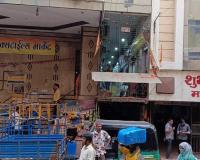Surat Fort Shines as a Heritage Icon on World Heritage Day

Surat, April 18 : As the world celebrates World Heritage Day, the historic Surat Fort, situated on the banks of the Tapi River, stands tall as a symbol of the city’s rich cultural legacy and architectural grandeur. Built in the mid-16th century, the fort continues to captivate visitors with its historical significance and well-preserved structure.
Commissioned by Sultan Mahmud Shah III of Ahmedabad between 1540 and 1546 to safeguard the city from repeated invasions, the fort was constructed under the supervision of Turkish military officer Safi Aga, also known as Khudavand Khan. Spread over nearly one acre, the fort is enclosed by 20-yard-high walls, 15 meters thick, and features four bastions, each measuring 12.2 meters in height and 4.1 meters in width. The Surat Municipal Corporation (SMC) has restored the fort to its former glory, preserving its unique blend of architectural styles from the Tughlaq, Gujarat Sultanate, Mughal, Dutch, and British eras.
Between 2022 and 2025, a total of 121,489 tourists visited Surat Fort, generating revenue of ₹83,72,040. In a notable initiative by the Municipal Primary Education Committee, 8,037 students from municipal schools and selected visitors were granted free access to the fort. Additionally, 627 foreign tourists also experienced the fort's majestic ambiance.
A dedicated team of 18 staff members manages and maintains the fort, which now serves not only as a monument of the past but also as a bridge connecting future generations with their heritage. Once a strategic outpost along the Tapi River, the fort bore witness to maritime trade, the rise and fall of empires, and the confluence of cultures.
Following a massive restoration project costing approximately ₹55 crore, the fort was virtually inaugurated by Prime Minister Narendra Modi on September 29, 2022, and opened to the public the following day. The project was entrusted to SMC by the state government in 2015.
Today, the fort features multiple themed galleries that house ancient stone sculptures and carvings. The complex includes six major buildings, four prominent towers, two incomplete minarets, a moat, and a drawbridge — all echoing the architectural styles of various ruling eras. Notable sections include the Diamond Hub, showcasing Surat's famed diamond industry; the Vault and Currency Room, highlighting the region’s monetary history; and the Arms and Wooden Artifacts Gallery, which offers a glimpse into maritime and military traditions.
The fort also presents a gallery of Gujarati handicrafts, featuring applique work, embroidery, and beadwork. One of the standout features is the "Hamam with Fresco," an artistic representation of Surat city. Approximately 35 theme-based galleries, integrated with the 135-year-old collection of the Sardar Vallabhbhai Patel Museum, further enrich the visitor experience.
To enhance digital engagement, the "Heritage Walk" mobile app was launched in March 2017. The app provides audio-guided tours, enabling visitors to explore the fort independently while learning about its historical depth.
Special attractions include the Ivory Art Gallery, which displays decorative items, gaming pieces, and a 19th-century model of a boat filled with travelers, and the Indian Bronze Art Gallery, which features bronze sculptures from Western, South Indian, and Himalayan traditions, along with Bidri artwork and religious artifacts.
As World Heritage Day is observed, Surat Fort stands not merely as a preserved monument but as a thriving educational and cultural hub that reflects the spirit of India’s ancient and diverse heritage.






